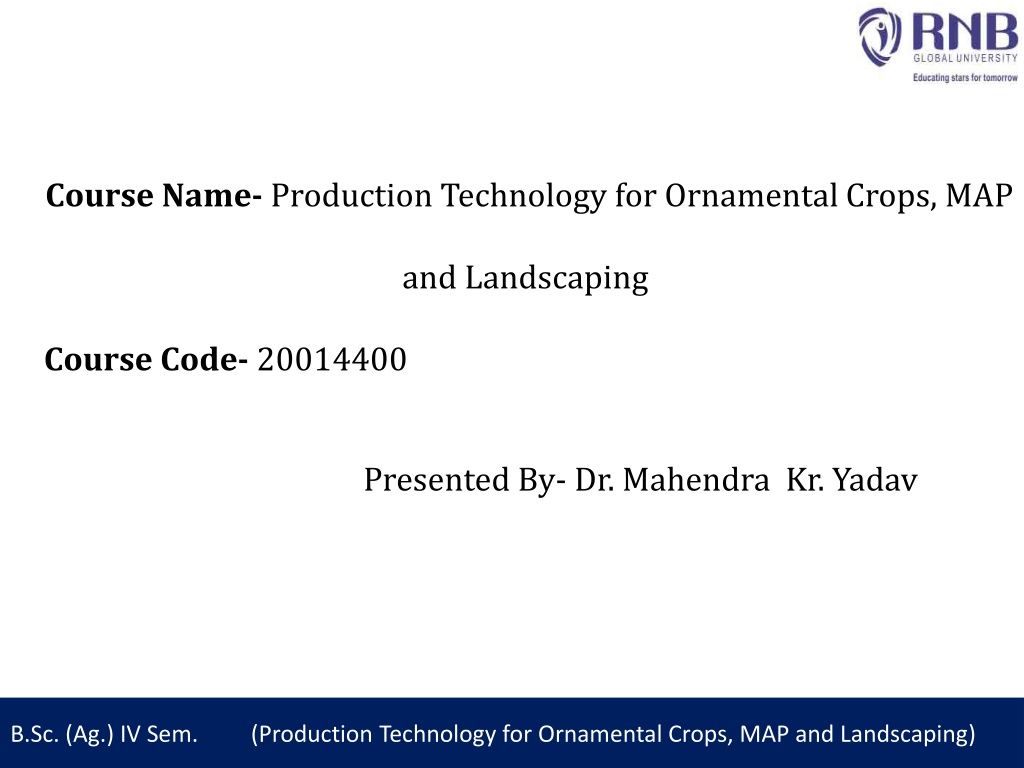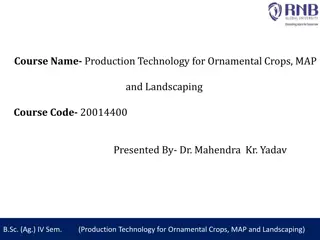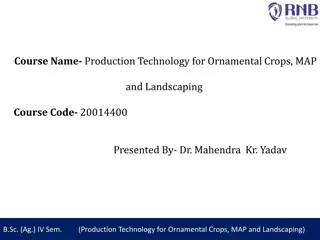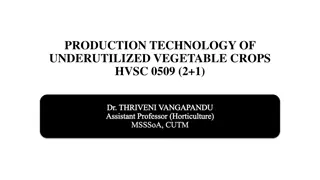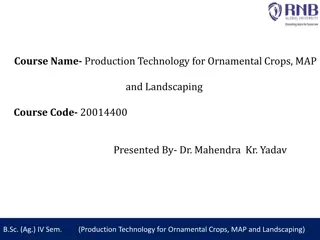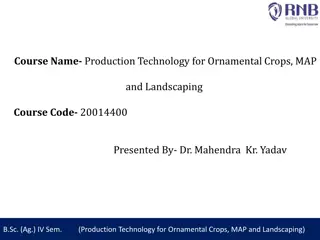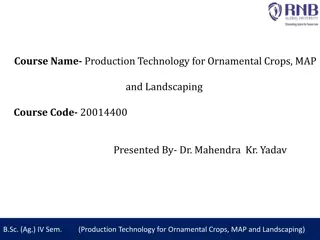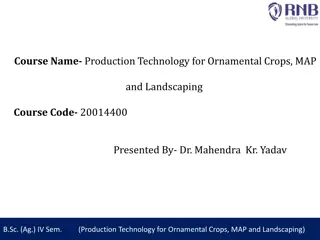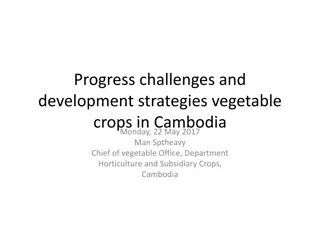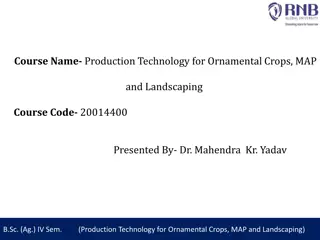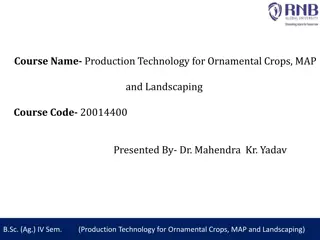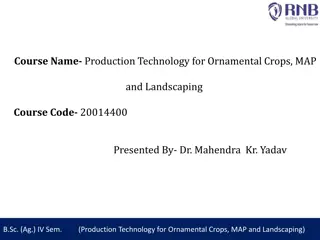Production Technology for Ornamental Crops and Landscaping: Ashwagandha Cultivation and Benefits
This course covers the production technology for ornamental crops, medicinal and aromatic plants, and landscaping practices. It emphasizes identifying different types of crops, landscaping principles, and the importance of processing and value addition in ornamental crops. Specifically, it explores the production technology of Ashwagandha, its botanical details, agricultural requirements, and health benefits. The content delves into the climate and soil conditions suitable for Ashwagandha cultivation, field preparation, and various uses of this plant in promoting health and well-being.
Download Presentation

Please find below an Image/Link to download the presentation.
The content on the website is provided AS IS for your information and personal use only. It may not be sold, licensed, or shared on other websites without obtaining consent from the author. Download presentation by click this link. If you encounter any issues during the download, it is possible that the publisher has removed the file from their server.
E N D
Presentation Transcript
Course Name- Production Technology for Ornamental Crops, MAP and Landscaping Course Code- 20014400 Presented By- Dr. Mahendra Kr. Yadav B.Sc. (Ag.) IV Sem. (Production Technology for Ornamental Crops, MAP and Landscaping)
Course Objectives Identify different types of ornamental and medicinal crops. Examine various principles of landscaping, uses of landscape trees, shrubs and climbers, production technology of important ornamental crops, etc. Determine about Demonstrate various Package of practices for loose flowers and their transportation, storage house and required condition for cut and loose flower. Construct about the various problems with the production technology of medicinal and aromatic plants. Importance of Processing and value addition in ornamental crops and MAPs produce. B.Sc. (Ag.) IV Sem. (Production Technology for Ornamental Crops, MAP and Landscaping)
Production technology of ashwagandha B.Sc. (Ag.) IV Sem. (Production Technology for Ornamental Crops, MAP and Landscaping)
Production technology of ashwagandha Botanical name : Withania Somnifera Family : solanaceae Chromosome Number :2n = 48. Uses of Ashwagandha Are used in strength and enhancers, drug formulation, arthritis, tumors, cancer, antimicrobial, immunomodulatory, antioxidant, anthelmintic, insomnia, weakness, ulcers, painful inflammation, blood pressure sedative, stigmatization, white stains etc. B.Sc. (Ag.) IV Sem. (Production Technology for Ornamental Crops, MAP and Landscaping)
Health Benefits of Ashwagandha - There are some health benefits of Ashwagandha- Ashwagandha improves the immune system. Ashwagandha helps to control cholesterol. It is good for our hearts. Ashwagandha promotes wound healing. Ashwagandha helps to reduce stress, depression, and anxiety. It stimulates underactive thyroid. It increases strength and muscle mass. It helps in reducing pain and swelling. It improves our memory power. It is beneficial to both males and females in their reproductive systems. It boots energy levels. It is good for the eyes and joints. It prevents cancer cells from growing B.Sc. (Ag.) IV Sem. (Production Technology for Ornamental Crops, MAP and Landscaping)
Climate - Tropical region where rainfall is 600 mm. to 1200 mm it is suitable for there. The crop needs open sunlight during its growing period. 20 C to 35 C the temperature is most suitable for its cultivation. Soil: Ashwagandha can be cultivated in different types of land. But loam soil with good drainage is most suitable. Sandy loamy or light red soil with pH it can also be cultivated in 7.5- 8.0 HO. Field Preparation: Before plowing, we plow the field properly. It does not require much fertilizer and fertilizer etc. for cultivation. But if the field is less fertile, 8 to 10 trolleys apply dung fertilizer per hectare. B.Sc. (Ag.) IV Sem. (Production Technology for Ornamental Crops, MAP and Landscaping)
Sowing Time: Ashwagandha is sown in the month of August or September after the rainy season. Advanced varieties of this crop should be grown for good production. Improved varieties: Jawahar Asgandh-20 and Jawahar Asgandh-134 Horticulture College, Mandsaur. In addition, Rakshita and Poshita are advanced varieties developed by CIMAP Lucknow. Seed rate: The crop of Ashwagandha requires a seed rate of 12 kg per hectare if you choose to go for the broadcasting method. The line-to-line method is best suited because it increases the root yield. The seeds should be sown about 2 cm to 3 cm deep and should be covered with light soil. Plant to plant distance of 8cm to 10 cm and line to line distance of 20 cm to 25 cm should be maintained. B.Sc. (Ag.) IV Sem. (Production Technology for Ornamental Crops, MAP and Landscaping)
Seed Germination: Ashwagandha germination starts within 10 to 15 days. After about a month, they decompose the plant of Ashwagandha. About 80 to 1000 plants are kept in a square meter and the remaining plants are removed. The distance from plant to plant is about 10-12 cm. Irrigation: Ashwagandha does not require much irrigation. But to maintain moisture in the field, irrigate at intervals of 15 to 20 days. More irrigation increases the amount of fiber in the roots, which reduces the quality of the roots. Manure and Fertilizer: Ashwagandha crop does not require much quantity of manure / fertilizer, yet cow dung manure has been considered profitable. Apart from this 20 kg Nitrogen and 40 to 50 kg P. Using sowing time per hectare increases productivity. B.Sc. (Ag.) IV Sem. (Production Technology for Ornamental Crops, MAP and Landscaping)
Pests and Diseases: Aphids, mites and insect attack, seedling rot and blight are some common pests and diseases found in ashwagandha cultivation. However, no serious pests are found in ashwagandha crops. Selecting disease-free seeds before sown is necessary to reduce these incidents. Bio-pesticides could be prepared from Neem, Datura, Cow s urine, Chitrakmool, to prevent Ashwagandha from diseases. Apart from this, having proper soil drainage and by adopting Crop rotation we can reduce the impact of any diseases. Post harvest and harvesting 1. The crop is ready for harvesting after 150 to 180 days. 2. The maturity of the crop is assessed by drying of leaves and yellow to red fruits. 3. The entire plant is uprooted and the root is thoroughly cleaned with water. 4. Then add it near the stem 1-2 cm. The top is cut off. The roots are followed by 7-10 cm in the cross. Is cut into pieces. B.Sc. (Ag.) IV Sem. (Production Technology for Ornamental Crops, MAP and Landscaping)
Grading of roots: The dried roots are beaten with a club to remove adhering soil and to break off thin, brittle, lateral rootlets. Lateral branches, root crown and stem remain are carefully trimmed with a knife. Root pieces are then sorted out into following grades. 1. "A grade root - root length up to 7 cm and thickness 1.0-1.5 cm, solid and bright white. 2. " B "grade root - root length 5 cm and thickness are 1.0 - 1.5 cm bright white. 3. 'C' grade root - the root length is 3-4 cm and thickness is less than 1 cm solid joints. 4. Low grade root - are small pieces of root cut from 50-75 kg seeds. B.Sc. (Ag.) IV Sem. (Production Technology for Ornamental Crops, MAP and Landscaping)
Yield: The yield of the Ashwagandha crop depends on soil fertility, irrigation, and farm management practices. We can obtain about 6 to 8 q of roots and 50 kg of seeds from one hectare land. Value addition: Value added products from Ashwagandha include root powder, capsules, root extract, herbal beer etc. in addition to the traditional drugs made from this plant. Health drinks, herbal tea, functional foods, nutraceuticals and cosmeceuticals are some of the value-added products on which enterprises can be set up. B.Sc. (Ag.) IV Sem. (Production Technology for Ornamental Crops, MAP and Landscaping)
